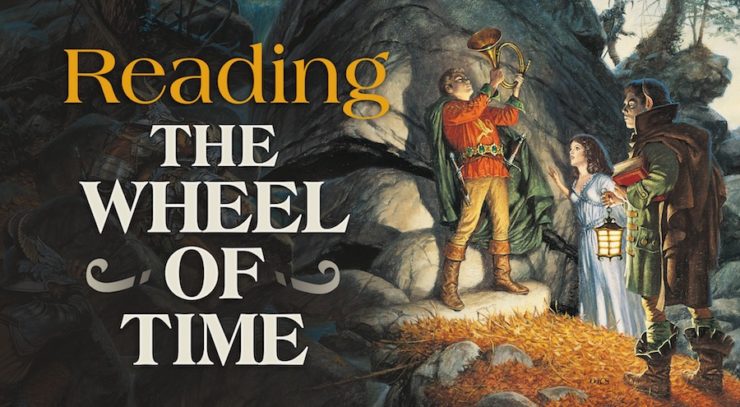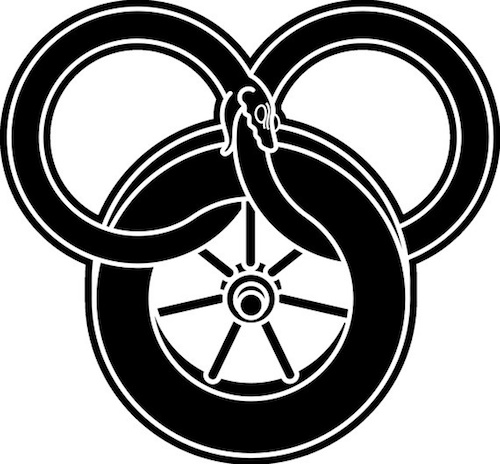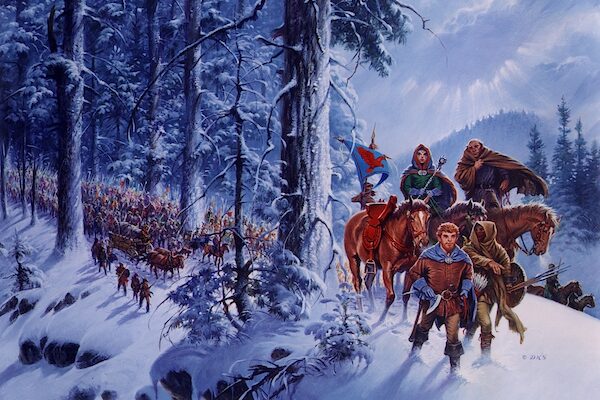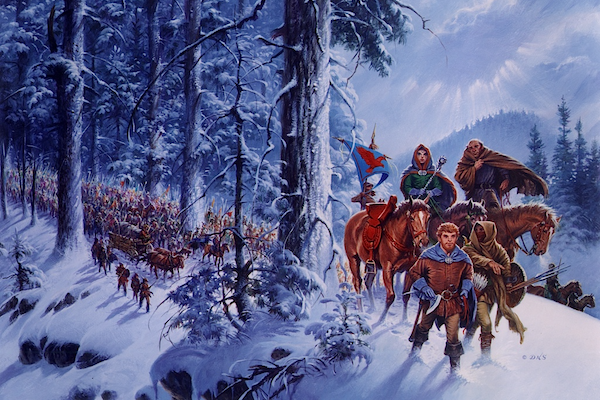There is a challenge to writing the opening chapters of the second novel in a series. The early pages have to meet the expectations of those readers who loved the first installment and have been eagerly awaiting the second, but it also must be intriguing and not too alienating for someone just discovering the author’s work for the first time. Once an author is several books into a beloved series, faithful readers might tolerate a slow start to a book, and someone just picking up book four or five won’t expect to be able to jump in and understand everything. But a second book is a real test for a series, I think, to see how it can stand up, how it can draw new interest and build a single novel, even a good one, into a story that reaches far beyond its origins.
If I picked up The Great Hunt in an airport bookstore and I read the opening pages, I would definitely be intrigued. Intrigued enough to hunt down and buy the book that came before, if I could find it, and maybe even to settle for starting the second without context if the bookstore only carried the one. It’s punchy, it’s dangerous, and it’s full of interesting clues that make me want to keep turning the page. Even if I wasn’t doing it for Reading The Wheel of Time.
Hello again, dear readers! Today we are starting off The Great Hunt, I’m quite excited about this one, I must say, and I already have a feeling that this book is going get much more immersive than The Eye of the World. Which makes sense, really. Now that Jordan has laid the groundwork, he can spend some time deepening the worldbuilding, and showing us what until now has only been hints left behind closed doors.
The Prologue opens with a man who calls himself Bors standing in a room of people in black silk masks. Bors contemplates the fact that, like him, none of these people knew where they were, only that they had been summoned. And so they had come, but unlike Bors, the others were not all adept at hiding their identities, even with the masks on. Noting their clothing, their jewelry, skin, bearing, and other details, he is able to identify the origins of many of the people with whom he shares the room, some even down to their house names, he even recognizes the clothing of a Tinker. Also among the group are two women bearing distinctive snake rings; Aes Sedai, who Bors refers to in his mind as witches. He curses them in his mind, thinking of how they “sat like spiders in the middle of a web, pulling the strings that made kings and queens dance, meddling….”
Just then a chime sounds, and the doors to the room open, admitting two Trollocs and a Myrddraal. The assembled masked people draw back in fear, huddling together, even the man who calls himself Bors, as the Myrddraal looks them over with a white face that has no eyes, reminding Bors of a maggot in a grave. The Myrddraal seems to be enjoying their fear, and Bors thinks that a day will come when the Dark Lord returns and chooses new Dreadlords, and that on that day the Myrddraal will cower before them. “Before me,” he thinks, but then the Myrddraal announces that their Master is coming.
Buy the Book
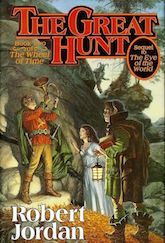

The Great Hunt
Bors realizes the meaning of the words when he sees the air shimmer above the Myrddraal and he falls to his face on the stone floor. He begins reciting a creed on his service to the Dark Lord, full of fear and panic, and in the back of his mind another voice, another recitation, keeps popping up, one that calls to the Creator for protection from the Shadow. He shoves the voice down with an effort, reminding himself that he left that voice behind a long time ago, that he serves a new master now. And then he hears a voice telling them all to rise.
Bors is shocked; he can’t imagine any of the people in the room daring to speak aloud, but neither can he imagine the voice of the Great Lord of the Dark sounding as mellifluous as that. He looks up carefully, to see the image of a man shimmering above the Myrddraal’s head, a figure in blood red robes and a mask to match, and again the man who calls himself Bors questions if the Dark Lord would appear to them in such a guise. But he sees the Myrddraal’s fear and the only other way he can think to explain this situation is that this is one of the Forsaken, an idea that is almost as frightening to Bors as seeing the Great Lord of the Dark himself. But if it is one of them, that means that the Day of the Dark One’s return must be close, and when the figure commends them again, this time snapping, he gets to his feet.
It is then that the man who calls himself Bors notices that the figure’s hands are burned, crossed by black fissures and red between the fingers. He hesitates, thinking neither the Dark Lord or one of the Forsaken would appear in such a way, but when the figure’s gaze sweeps across him he can feel a furnace behind it.
The figure gives its name as Ba’alzamon, and the man who calls himself Bors is shocked, because he knows that as the Trolloc name for the Dark One. For humans the word is forbidden to be spoken, not as forbidden as his true name, Shai’tan, but still not to be spoken.
Ba’alzamon tells them that the building they are in stands in the shadow of Shayol Ghul, and that the fact that he can appear before them shows that his return is close at hand. He makes great promises to them, that the Wheel will be broken and the Great Serpent will die, that he will remake the world in his image and they will sit at his feet and be lords, who live and rule forever.
Then he shows them an image of three boys, first, a country boy with a mischievous expression, then a curly-haired youth who looks as muscled as a blacksmith and carries a battle axe and has strange yellow eyes, then a fair young man with red hair and eyes that shift between grey and blue, who carries a heron-marked sword. Ba’alzamon tells the assembled crowd that the one who will be the Dragon walks the earth again, and that he must be turned to Ba’alzamon’s service. He explains also that the three young men are to be part of the threads he wishes to weave in the pattern, and that they should all study them carefully so that they will know them.
Bors soon realizes that each person in the room is receiving instructions, though no one else can hear them or the person’s replies. He waits impatiently for his turn, until at last he hears his name. Ba’alzamon’s masked face fills his vision, although somehow he can still also see the room beyond it. Ba’alzamon asks if he is faithful, and Bors replies that he his, that he cannot hide from Ba’alzamon. He is instructed to return home and continue his work, and to watch for the three boys. When he asks if they are dangerous, Ba’alzamon replies that a sword is dangerous but only to the man at the point, not the man at the hilt, unless the man at the hilt is a fool, careless, or unskilled, in which case the sword is doubly dangerous to him. Then he gives Bors a third set of instructions, which makes the man’s mouth fall open in astonishment. He cannot understand the point of them, and wonders if knowing the others’ instructions would help.
Abruptly he felt his head grasped as though by a giant hand crushing his temples, felt himself being lifted, and the world blew apart in a thousand starbursts, each flash of light becoming an image that fled across his mind or spun and dwindled into the distance before he could more than barely grasp it. An impossible sky of striated clouds, red and yellow and black, racing as if driven by the mightiest wind the world had ever seen. A woman—a girl?—dressed in white receded into blackness and vanished as soon as she appeared. A raven stared him in the eye, knowing him, and was gone. An armored man in a brutal helm, shaped and painted and gilded like some monstrous, poisonous insect, raised a sword and plunged to one side, beyond his view. A horn, curled and golden, came hurtling out of the far distance. One piercing note it sounded as it flashed toward him, tugging his soul. At the last instant it flashed into a blinding, golden ring of light that passed through him, chilling him beyond death. A wolf leaped from the shadows of lost sight and ripped out his throat. He could not scream. The torrent went on, drowning him, burying him. He could barely remember who he was, or what he was. The skies rained fire, and the moon and stars fell; rivers ran in blood, and the dead walked; the earth split open and fountained molten rock….
The vision ends and the man who calls himself Bors finds that they fade from his memory as quickly as they were put there. Ba’alzamon tells him that some instructions are too important for even the man who carries them out to know them. Bors bows and the masked face vanishes.
Bors studies the images again, naming them in his mind as the Trickster, the Blacksmith, and the Swordsman. From Bors’ orders alone he thinks they could die at any time, and yet they are important enough to be made the center of this gathering. He ponders this, frustrated by the lack of answers, until a servant appears at his elbow. He realizes that the Myrddraal and Trollocs are gone, as is the door through which they entered, and there is a servant arrived for each one of the black-masked people in the room.
He is told that he can change back into his own clothes if he wishes, that no one will see him leave the place or arrive at his destination, and is then left alone. Feeling anxious, a small part of Bors whispers that even immortality isn’t worth another encounter like this, but he laughs it away. For that much power there is nothing he would not do. He takes his usual cloak from his saddlebags, fingering the white fabric and the golden starburst and red crook emblem pinned to it. And he almost laughs, thinking of the great work to be done in Tarabon, and on Almoth Plain.
Greed is such an amazing thing, isn’t it? Given how much fear the Dark One instills even in the people who serve him, it’s amazing to imagine that people who actually come face to face with him have a motivation strong enough to conquer that fear. Perhaps some of the Darkfriends in that room are more afraid of death than they are of facing even Ba’alzamon while they are alive. Perhaps others signed away their souls before they understood in their hearts what the Dark One really was, and by that time the fear of being caught turning away from the Dark was greater than the fear of staying in its shadow. But for Bors, at least, it really is greed and ambition that drive him, a desire so strong that we see him actively fighting his better instincts, instincts that recognize the danger and the horror and turn to a mantra of the Light without his bidding. Moiraine, and I think Captain Bornhald as well, have has said that there is no one so deep in the Shadow that can’t return to the Light, but I think it means something more to see it here in someone actually entrenched in the Dark, and it makes me wonder if we won’t see a redemption story of a Darkfriend somewhere in the series. It seems too important of a theme not to be addressed.
When I started this read back in February 2018, I left out the prologue to The Eye of the World for several weeks, because although it was interesting, I wasn’t sure what I could say about it from an analytical point of view. It was well written and it made me want to learn more, but it didn’t immerse me in a place and time the way this one does. I think the close point of view from Bors helps immensely with that, giving us a set of emotions to attach to the proceedings. In many ways this makes the prologue feel more like a regular chapter than something separate, and I wonder why Jordan chose to change the format this way.
Buy the Book
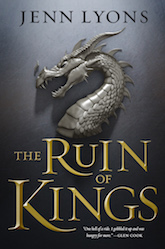

The Ruin of Kings
I assume that at some point in The Great Hunt we will meet the man who called himself Bors, but of course it will be under another name, and we, like the masked people in that room, won’t recognize him at all. It will probably be some time before that particular reveal, but every time we meet a Whitecloak from here out, the reader is going to be wondering if this is the man who called himself Bors. It’s a really great seed to be planted at the beginning of the story, and it will pay off in some great tension later. Not that I really needed another reason to feel tense when the Children of the Light show up.
I didn’t mention the creepy servants in the recap, but how about that disturbing bit of detail? Blank eyes. Empty eyes. A doll’s eyes. Eyes more dead than death. I don’t know what they did to those servants, but it might be creepier than the Trollocs. I also found it interesting that Bors was more put off by the fact that such measures had been carefully thought of by “his current masters.” I wasn’t sure what he meant by that; obviously he doesn’t think of Ba’alzamon as someone he’ll eventually find weakness in or move beyond, so I suppose he must be thinking that there is a higher tier of Darkfriends who have orchestrated this gathering and he aspires to find their weaknesses and exploit them in order to rise above them. His ultimate goal seems to be to be named one of the Dark One’s new Dreadlords, and certainly it stands to reason that not all of the Darkfriends who serve Ba’alzamon now will be granted the gifts he promises. (Or you know, any of them because why would the Dark One need, or care about, any human after he has won? But that’s another discussion.) Bors’ uncertainty when Ba’alzamon mentions the Dragon serving him in another Age is worth noting as well; a clue to the reader that these Darkfriends’ scheming and striving for this immortality is fruitless and the promise only a means to an end in which they will ultimately be discarded. I remember Gode’s “reward” all too well.
I spent some time looking at the vision Bors receives, trying to see if I recognized any of the images, but the only ones that meant anything were the obviousness of the wolf relating to Perrin and/or Elyas and the golden horn likely being the Horn of Valere being sounded, after which “the dead walked.” So perhaps the Dark One has some plan to use the Horn in his battle against the world. On my first readthrough of this chapter, I was thinking that what Bors sees is a premonition of an actual future to come, but I’m reminded on my second pass that the vision is a set of instructions, not a premonition. Given that the wolf in the vision rips Bors throat out, one wonders if Ba’alzamon’s instructions include a command that will send this man to his death, possibly at Perrin’s hands. Poor Perrin, seems that he has more strife with the Children of the Light coming his way.
Do you think Moiraine, for all her schemes and plots, has any idea how organized the other side is? Although we haven’t yet seen much of the other Aes Sedai, if she has allies in the White Tower they almost have to be few in number and status, whereas the bad guys have a centralized assembly and are well prepared to carry out active instructions. As a reader, it really ups the stakes for me to see that this isn’t just about the raw power of the Dark One and the Forsaken, not just about the temptation and fear that Ba’alzamon can instill, but also about a long and complicated plot with many threads. In the last section of the read of The Eye of the World, I said I didn’t believe Ba’alzamon’s claim that he orchestrated everything to lead Rand to him in that moment before their confrontation. It seemed like too much, even for someone like the Dark One. I still do think that it was a lie, but I will say that this prologue shows that he has much more ability to organize complex schemes that I realized at the time. I don’t think anyone fighting for the Light can have any idea of it either.
Can I just say, though, that there is something about the theater of Ba’alzamon that doesn’t sit quite right for me? I can’t put my finger on it, but it’s clear that there is something hidden about him that neither we the reader, nor the Dark One’s enemies, nor his followers, is seeing. I mean, even as I write that it feels too obvious to even say, but Bors’ questioning of why Ba’alzamon would appear human got me thinking about it. Obviously a human form that people can look at safely with their naked eye isn’t the true form of the Dark One, but I assumed it was just a convenient image projected from his prison, embodying only the barest fraction of his power. But if that is the case, why would his hands appear burned? This is clearly the damage from his battle with Rand, but for it to show in such a way means either that it is some kind of psychic manifestation of the damage that Ba’alzamon cannot hide, or that there is some kind of real physical entity at play here. Real hands with real burns? How is that possible? I don’t know, but I think it is a very important clue all the same.
During the read of The Eye of the World, some of the commenters pointed out the icons at the top of the chapters to me and suggested that I pay attention to how they relate to the chapters they precede. So far it has seemed fairly straightforward to me; a raven in the icon heralds a raven in the story, a staff in the icon turns out the signify an important moment with Moiraine’s staff, etc. But I have been making sure to look at them more closely, and the icon for this section really caught my attention.
It’s the same icon that was used before the Prologue and Chapter 1 in The Eye of the World and at the end of every chapter, but for some reason this is the first time I really looked at it. (So thanks for pointing that out, team!) The prologue’s icon is snake eating its own tail, intertwined with a wheel.
So far there have been only a few mentions of the Great Serpent by characters in The Wheel of Time, not really enough information for me to make much out of it. Of course there is some mythology in our own world that Jordan is no doubt drawing from here; the ouroboros, a dragon or snake eating its own tail, is a motif image that dates as far back as Egyptian times, and came to modern symbolism through Greek tradition, Medieval alchemy, and the tradition of Renaissance ceremonial magic. The ouroboros, generally speaking, has a meaning relating to infinity, to wholeness, and to the idea of an ongoing cycle of rebirth, without beginning or end. It is a fitting symbol for a world that exists via a turning wheel that spins out Ages and sometimes reincarnates people (or at least one person. I’m still unclear on this). That the Aes Sedai wear this symbol also makes sense, it is an image of the very thing they seek to protect, the continuation of the world, the Wheel forever turning, and the cycle unending.
The other obvious connection to real-world mythology is of course to the Great Serpent of Norse mythology, Jörmungandr, the offspring of Angrboða and Loki, whose body is supposed to circle all of the world, and whose final battle with Thor is supposed to occur during Ragnarok, when both will be killed and the world will be destroyed. Given all the talk about the return of the Dragon heralding the destruction of world, this connection makes sense, and I assumed that the Great Serpent, like Jörmungandr, circled either the world of The Wheel of Time or perhaps circled the Wheel itself, guarding it perhaps. But it hadn’t occurred to me to picture it entwined with the wheel, as it is shown in the icon here. Since it is the One Power that drives the wheel, I don’t imagine the Serpent has a role in turning it, but perhaps the Wheel effects the Serpent in some way, and its existence is more than symbolic in the fall of the world and the Wheel itself.
Given this connection to Norse myth, I kind of wonder if the Horn of Valere isn’t partly inspired by the horn of Heimdall, the watcher of Asgard, which when blown will let all the gods know that Ragnarok is upon them. I don’t remember that horn having the power to summon anyone from the grave, but given that the Horn of Valere is only meant to be blown at the most desperate hour, its sounding will very well signal the end of the world as well, or at least a strong possibility of it.
Next week I will be covering Chapters 1-3 of The Great Hunt, and we’ll be back in Fal Dara with Rand and his friends, along with a new arrival that threatens to upset everything for Rand, and for Moiraine as well. Until then, meet me down at the comments, white out your spoilers, and let me know how you felt when you first picked up The Great Hunt and saw the story continue.
Sylas K Barrett loves snakes, and he may have a new rival for his favorite piece of fictional snake jewelry, a title previously held by Aragorn’s Ring of Barahir.










